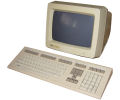| cosam.org |
Terminal, Power Controller and VTServer

Today I acquired a DEC VT220 terminal, which was advertised on the Internet, for the princely sum of €5. After setting up the terminal (9600/8/N/1 as I'd used on my PC's terminal emulator) I hooked it up to the PDP using 9-pin null-modem cable and two 9-to-25-pin adapters. Finally - something that worked straight away. Hitting break from keyboard even drops you into ODT.
On the theme of remote control, I figured I'd try to set up the power controller in the bottom of the cabinet. Power cords from the controller to the system components were already connected, but I flipped the circuit breakers on the RL02s to OFF to avoid overloading anything when powering up. The AUX power cable from system box was connected to the power controller. Making sure the small switch on the back of the controller was in the OFF position, I applied power to the controller and the red lamp on the back illuminated. Switching the circuit breaker to ON gave a reassuring clunk as current entered the box. Moving the small switch to the "Remote" setting now allows the system to be started using the AUX power switch on system box front panel.
The main goal of the day was to set up
VTServer ![]() ,
a rather nifty little program which can
be used to transfer data from a Unix box to the PDP-11 via the serial
console. This is very handy if, like me, you don't actually have a
tape drive, or your tape drive isn't supported by the software you
want to install. Setting up VTServer would prove that the PDP-11 is
able to run a program, even if this wasn't yet of any use seeing as
I have no storage devices connected to the system.
,
a rather nifty little program which can
be used to transfer data from a Unix box to the PDP-11 via the serial
console. This is very handy if, like me, you don't actually have a
tape drive, or your tape drive isn't supported by the software you
want to install. Setting up VTServer would prove that the PDP-11 is
able to run a program, even if this wasn't yet of any use seeing as
I have no storage devices connected to the system.
Installation was pretty easy, although on my particular system I needed to remove the prototype of errstr() from vtserver.c before it would compile. I experimented with several programs by placing these in the .vtrc file, all of which were loaded and run perfectly by the PDP. A useful feature of VTServer is the ability to load the short bootstrap program into the PDP using ODT. For this to work, I needed to start the machine on HALT in order to drop straight to the ODT prompt (VTServer "types" the bootstrap code here) then flip to RUN. You can then boot the system by running "./vtserver -odt" on the Unix box.
Transfering data over the virtual tape is however not the fastest way to install an OS or pump over a disk image. The MXV11 is now set to the default speed of 9600 bps, meaning a RL02 disk image of 10MB would take about 3 hours to transfer. The console can however be set to run at four times this speed: 38.4 Kbps. I therefore tried to set up the faster baud rate for the console (SLU1) as per MVX11 manual. Initial tests at 38.4 Kbps weren't very promising. There was no output to console at startup, so I reverted to 9600 bps for the time being.
Next: 38.4 Kpbs console >>